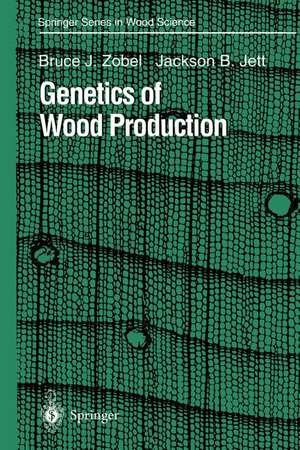Genetics of Wood Production: Springer Series in Wood Science
Autor Bruce J. Zobel, Jackson B. Jetten Limba Engleză Paperback – 14 dec 2011
Din seria Springer Series in Wood Science
- 18%
 Preț: 1543.84 lei
Preț: 1543.84 lei - 23%
 Preț: 2062.76 lei
Preț: 2062.76 lei - 18%
 Preț: 1824.32 lei
Preț: 1824.32 lei - 24%
 Preț: 817.72 lei
Preț: 817.72 lei - 18%
 Preț: 1225.16 lei
Preț: 1225.16 lei - 18%
 Preț: 3288.92 lei
Preț: 3288.92 lei - 18%
 Preț: 948.29 lei
Preț: 948.29 lei - 18%
 Preț: 1222.31 lei
Preț: 1222.31 lei - 18%
 Preț: 2093.60 lei
Preț: 2093.60 lei - 18%
 Preț: 946.87 lei
Preț: 946.87 lei - 18%
 Preț: 1122.87 lei
Preț: 1122.87 lei - 18%
 Preț: 1020.30 lei
Preț: 1020.30 lei - 24%
 Preț: 836.42 lei
Preț: 836.42 lei - 20%
 Preț: 569.49 lei
Preț: 569.49 lei - 15%
 Preț: 638.89 lei
Preț: 638.89 lei - 15%
 Preț: 636.30 lei
Preț: 636.30 lei - 15%
 Preț: 635.31 lei
Preț: 635.31 lei - 18%
 Preț: 878.05 lei
Preț: 878.05 lei - 15%
 Preț: 646.43 lei
Preț: 646.43 lei - 18%
 Preț: 1004.67 lei
Preț: 1004.67 lei - 18%
 Preț: 894.03 lei
Preț: 894.03 lei - 15%
 Preț: 658.70 lei
Preț: 658.70 lei - 15%
 Preț: 641.53 lei
Preț: 641.53 lei - 18%
 Preț: 950.84 lei
Preț: 950.84 lei - 18%
 Preț: 783.35 lei
Preț: 783.35 lei - 15%
 Preț: 645.79 lei
Preț: 645.79 lei - 24%
 Preț: 880.81 lei
Preț: 880.81 lei -
 Preț: 388.13 lei
Preț: 388.13 lei - 18%
 Preț: 780.82 lei
Preț: 780.82 lei - 15%
 Preț: 529.13 lei
Preț: 529.13 lei
Preț: 643.34 lei
Preț vechi: 756.86 lei
-15% Nou
Puncte Express: 965
Preț estimativ în valută:
123.11€ • 131.64$ • 102.64£
123.11€ • 131.64$ • 102.64£
Carte tipărită la comandă
Livrare economică 18 aprilie-02 mai
Preluare comenzi: 021 569.72.76
Specificații
ISBN-13: 9783642795169
ISBN-10: 3642795161
Pagini: 356
Ilustrații: XV, 337 p.
Dimensiuni: 155 x 235 x 19 mm
Greutate: 0.5 kg
Ediția:Softcover reprint of the original 1st ed. 1995
Editura: Springer Berlin, Heidelberg
Colecția Springer
Seria Springer Series in Wood Science
Locul publicării:Berlin, Heidelberg, Germany
ISBN-10: 3642795161
Pagini: 356
Ilustrații: XV, 337 p.
Dimensiuni: 155 x 235 x 19 mm
Greutate: 0.5 kg
Ediția:Softcover reprint of the original 1st ed. 1995
Editura: Springer Berlin, Heidelberg
Colecția Springer
Seria Springer Series in Wood Science
Locul publicării:Berlin, Heidelberg, Germany
Public țintă
ResearchCuprins
1 The Role of Genetics in Wood Production-General Concepts.- 1.1 Background Information.- 1.2 Categorization of Wood and Trees.- 1.3 Wood Properties of Importance.- 1.4 The Causes and Types of Wood Variation.- 1.5 Environmental vs. Genetic Influence on Wood.- 1.6 Literature on the Inheritance of Wood.- 1.7 Summary.- 2 Genetic Controls in Wood Formation.- 2.1 Controls Influencing Wood Development.- 2.2 The Value of Genetic Differences in Wood.- 2.3 Summary.- 3 Sampling and Analysis in Genetic Studies on Wood.- 3.1 Making Wood Studies — Sampling Methods.- 3.2 Size of Sample.- 3.3 Location and Age of Sample.- 3.4 Obtaining Wood Samples.- 3.5 Methods of Determining Wood Density.- 3.6 Methods of Determining Other Wood Properties.- 3.7 Indirect Selection for Wood and Pulp Properties.- Appendix Table 3.1 Some methods used to determine wood density in trees.- Appendix Table 3.2 Some methods that have been used to determine spiral grain.- 4 The Importance of Wood Density (Specific Gravity) and Its Component Parts.- 4.1 General Concepts and the Importance of Wood Density.- 4.2 The Effect of Genetic Manipulation of Wood Density on the Final Product — General.- 4.3 Summary.- 5 The Genetics of Wood Density.- 5.1 General.- 5.2 The Genetic Control of Wood. Density in ·the Conifers.- 5.3 The Genetic Control of Wood Density in Hardwoods.- 5.4 Genetic Gains in Wood Density Using Vegetative Propagation and Coppice.- 5.5 Inheritance of Within-Tree Variation in Wood Density.- 5.6 Summary.- 6 Inheritance of the Cellular Components of Wood, Cellulose Yield and Pulp and Paper Products.- 6.1 General Concepts.- 6.2 Cells of the Hardwoods.- 6.3 Cells of the Conifers.- 6.4 Cellulose Yield and Pulp and Paper Products.- 6.5 Summary.- 7 Grain, Fibril Patterns, and Internal Defects.- 7.1General.- 7.2 Spiral Grain.- 7.3 Microfibrillar Angle.- 7.4 Miscellaneous Wood Grain Patterns, Figured Wood.- 7.5 Reaction Wood.- 7.6 Cracks, Shake, and Other Internal Defects.- 7.7 Summary.- 8 Tree Form and Internal Tree Characteristics.- 8.1 Introductory Comments.- 8.2 Stem. Form and Branching.- 8.3 Juvenile Wood and Genetics.- 8.4 Chemistry of Wood.- 8.5 Miscellaneous Traits.- 8.6 Summary.- 9 Wood Genetics Related to Provenance and Seed Source.- 9.1 The Meaning of Provenance and Seed Source.- 9.2 The Overall Effect of Provenance.- 9.3 S Summary.- 10 Correlations Among Wood Properties and with Growth Rate.- 10.1 General Concepts.- 10.2 Growth Rate and Wood Properties.- 10.3 Wood Property Relationships in the Conifers.- 10.4 Relationships Among Wood Properties in Hardwoods.- 10.5 Relationship of the Wood Properties of Coppice, Rooted Cuttings, and Grafts to Donor Trees.- 10.6 Wood Property Relationships Between Chemical Composition and Pulp Properties.- 10.7 Summary.- 11 The Genetics of Miscellaneous Factors That Affect Wood.- 11.1 What Are Miscellaneous Factors?.- 11.2 Diseases and Insects.- 11.3. Wood Uniformity.- 11.4 Hybridization to Change Wood Properties.- 11.5 Effects of Polyploidy on Wood.- 11.6 The Effect of Tissue Culture and Biotechnology.- 11.7 Wood for Energy.- 11.8 Summary.- 12 Determination of Wood Properties to Be Used in a Tree Improvement Program.- 12.1 Using Genetic Information.- 12.2 Selection of Trees for a Genetics Program.- 13 Improvement in Wood by Using Genetics.- 13.1 Current and Future Usage of Genetics to Change Wood.- 13.2 Examples of Changes in Wood by the Use of Genetics.- 13.3 Improving Wood When There Is a Negative Correlation with Growth Rate.- 13.4 Summary.- References.- Species Index.




